Calcifediol (Calcidiol, semiactivated Vitamin D) - many studies
Asked Chat-GPT 2 questions about calcifediol based on the studies on this page - Jan 2024
1) Please summarize the attached PDF
Calcifediol is generally a better supplement than cholecalciferol in specific situations due to its different pharmacokinetic properties. It is more effective for individuals with certain conditions, such as liver disease or malabsorption issues, because it bypasses the liver's 25-hydroxylation process. This makes it more efficient in increasing serum 25(OH)D levels. Additionally, calcifediol is preferred when a rapid increase in vitamin D levels is required, such as in acute situations like early stages of COVID-19. However, for regular supplementation in healthy individuals without specific conditions, cholecalciferol is often adequate and more cost-effective.
2) Is there a faster response to calcifediol ?
Calcifediol provides a faster response in increasing serum 25(OH)D levels compared to cholecalciferol. This is particularly relevant for patients requiring a rapid increase in vitamin D levels, such as in acute cases or in those with certain medical conditions like liver disease or malabsorption issues. Calcifediol's efficacy in rapidly elevating vitamin D levels makes it a preferred option in specific clinical scenarios where immediate therapeutic effects are desired.
📄 The PDF given to Chat-GPT - if you wish to ask another question
Response to weekly Calcidiol - RCT Feb 2025
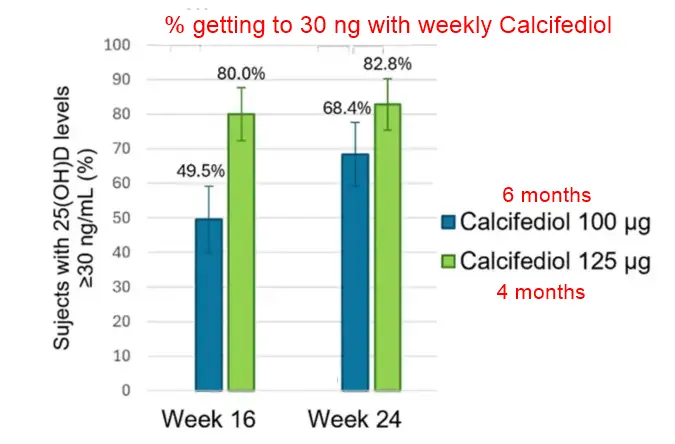
📄 Download the PDF from VitaminDWiki
Calcidiol: Prescription typically needed, expensive, might be fast
Calcidiol supplementation may be be essential to get Vitamin D if there is poor liver function
Calcidiol is far more expensive than Vitamin D
Fast Vitamin D response is essential in some cases - such as early COVID
- It appears that Calcidiol provides a fast response (mixed indications)
- Nanoemulsion Vitamin D might also provide a quick response - personal observation, no data yet.
VitaminDWiki - Calcidiol category contains
{include}
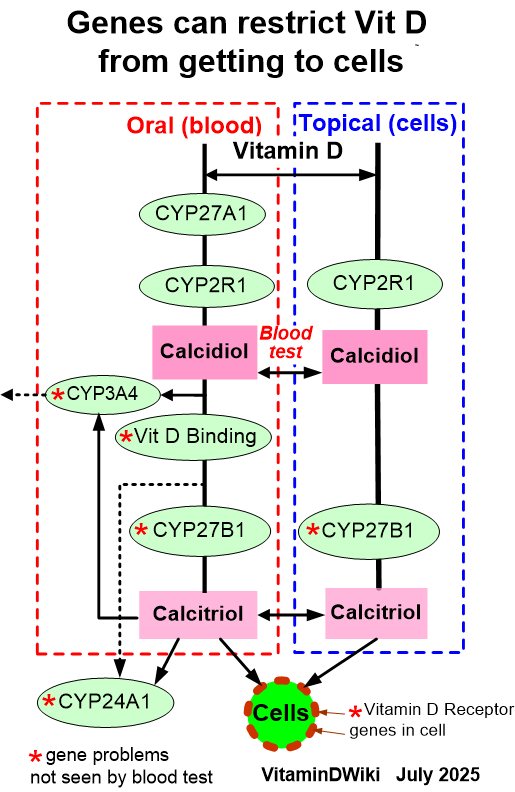
click on image for details
See COVID related
Treat COVID early with high-dose Vitamin D (20th as of June 2022)
COVID hospital deaths reduced 2X by 8 days of UVB – pilot RCT May 2022
Surviving COVID with vitamins and minerals is not a myth – June 2022
{include}
Weekly Calcifediol improved Vitamin D levels in HIV patients (but not at other dosing intervals) - Dec 2024
Effectiveness of supplementation with different doses of calcifediol in HIV patients with vitamin D deficiency
Enfermedades Infecciosas y Microbiología Clínica partial PDF Spain
Background
People with HIV (PWH) often exhibit vitamin D deficiency, with ambiguous treatment guidelines. This study evaluates the effectiveness of three vitamin D3 calcifediol supplementation regimens over 48 weeks, aiming to identify patients whose serum levels do not increase above 20 ng/mL.
Methods
In this prospective observational study, 112 HIV-positive outpatients with 25OHD levels below 20 ng/mL were assigned to one of three supplementation groups.
Group 1 received 16,000 IU weekly for 12 weeks, then biweekly;
Group 2 received 180,000 IU every 12 weeks;
Group 3 received 180,000 IU every 4 weeks for the first 12 weeks, then every 12 weeks.
- (Note by VitaminDWiki: 16,000 IU *4 = 64,000 IU)
The groups were compared using ANOVA and Chi-squared tests.
Results
The average participant age was 51.59 years, with 71.4% being male, all on antiretroviral therapy for an average of 9.5 years.
By week 48,
Group 1 showed the lowest percentage of patients with levels below 20 ng/mL (10.2%),
significantly outperforming Group 2 (44%) and Group 3 (31.6%).
Vitamin D levels significantly increased in Groups 1 and 3, with no significant change in calcium, phosphorus and bone density between groups. The CD4:CD8 ratio increased significantly in all groups. No side effects were observed.
Conclusions
The regimen of 16,000 IU calcifediol weekly for 12 weeks followed by biweekly dosing is both safe and effective for PWH, significantly increasing vitamin D levels and improving the CD4:CD8 ratio without adverse effects.
Monthly Calcifediol: >4 months to get to 20ng, bi-weekly just 1 month - Jan 2024
Efficacy and Safety of Calcifediol in Young Adults with Vitamin D Deficiency: A Phase I, Multicentre, Clinical Trial—POSCAL Study
Nutrients Volume 16 Issue 2 10.3390/nu16020306
by Pedro Guerra López 1,Mikel Urroz Elizalde 1,2ORCID,Noelia Vega-Gil 3,Blanca Sánchez Santiago 3ORCID,Iñaki Zorrilla Martínez 4,5,6,7,8,Mario Jiménez-Mercado 4ORCID,Esteban Jódar 9,10,Araitz Landeta Manzano 11,Cristina Campo Hoyos 11,* andJesús Frías Iniesta 1,2
Bi-weekly gets to 20 ng level faster

Vitamin D deficiency is highly prevalent, and recent evidence suggests a possible association between vitamin D deficiency and various health conditions. The aim of this study was to assess monthly calcifediol treatments for vitamin D deficiency (or biweekly, if the deficiency was severe) in a young adult population with no associated comorbidities. This multicentre phase I trial started with a four month open-label treatment phase (TP) that included 101 participants (65% women with mean age 29.8 years). Eighty-two percent of the subjects (79/96) achieved 25(OH)D levels within the target range (20–60 ng/mL) by the end of the TP, and they were subsequently randomised and subjected to a double-blind, placebo-controlled, five month follow-up phase (FP). At the end of the FP, 89% of participants maintained vitamin D levels of >20 ng/mL with calcifediol, versus 49% with placebo (p < 0.001). Subjects receiving monthly calcifediol during both phases (n = 32) maintained 25(OH)D levels >20 ng/mL, whereas those on the placebo during the FP (n = 38) exhibited deficiency levels of 25(OH)D by the end of the study. No clinically relevant changes in bone metabolism parameters or toxic 25(OH)D levels were observed, and no serious adverse events were reported throughout the study. Calcifediol is a safe and effective treatment for vitamin D deficiency in the young adult population, but long-term use may be required to sustain optimal 25(OH)D levels.
📄 Download the PDF from VitaminDWiki
13% of Adverse Events were due to the supplementation (clipped from PDF)
During the study, 66 AEs were reported by approximately one-third (n = 36, 36%)
of the safety population (n = 101). Of the total AEs, nine (13.64%) were considered to be
potentially related to the study treatment; all of them occurred during the treatment phase,
and they were reported by five (5%) participants in the group who were being administered
calcifediol each month.
Note: Reponse to Vitamin D does not appear to degrade with monthly dosing
Vitamin D given daily, weekly, or monthly has similar response (116 RCTs) – meta-analysis Aug 2023
Vitamin D response independent of dosing interval – meta-analysis July 2023
Cholecalciferol or Calcifediol in the Management of Vitamin D Deficiency - May 2020
Nutrients 2020 May 31;12(6):1617. doi: 10.3390/nu12061617.
Manuel Sosa Henríquez 1 2, M Jesús Gómez de Tejada Romero 3
Vitamin D deficiency is a global health problem due to its high prevalence and its negative consequences on musculoskeletal and extra-skeletal health. In our comparative review of the two exogenous vitamin D supplementation options most used in our care setting, we found that cholecalciferol has more scientific evidence with positive results than calcifediol in musculoskeletal diseases and that it is the form of vitamin D of choice in the most accepted and internationally recognized clinical guidelines on the management of osteoporosis. Cholecalciferol, unlike calcifediol, guarantees an exact dosage in IU (International Units) of vitamin D and has pharmacokinetic properties that allow either daily or even weekly, fortnightly, or monthly administration in its equivalent doses, which can facilitate adherence to treatment. Regardless of the pattern of administration, cholecalciferol may be more likely to achieve serum levels of 25(OH)D (25-hydroxy-vitamin D) of 30-50 ng/mL, an interval considered optimal for maximum benefit at the lowest risk. In summary, the form of vitamin D of choice for exogenous supplementation should be cholecalciferol, with calcifediol reserved for patients with liver failure or severe intestinal malabsorption syndromes.
Conclusions (clipped from PDF)
Based on our current knowledge, treatment of vitamin D deficiency should be aimed to maintain
stable and continuous serum levels of 25(OH)D in a range of approximately 30 to 50 ng/mL,
which appears to be optimal in terms of maximizing benefits and minimizing risks of vitamin
D, regardless of the myriad of genetic and/or environmental factors that may influence the vitamin D
status of patients.
In our opinion, and based on the available scientific evidence, cholecalciferol is the form of vitamin
D that can ensure that the vast majority of patients with vitamin D deficiency are within the optimal
range of efficacy and safety in a long-term period.
Therefore, based on our review of differential pharmacological characteristics and scientific
evidence, cholecalciferol should be used and prescribed in the majority of vitamin D deficiency clinical
settings instead of calcifediol.
📄 Download the PDF from VitaminDWiki
Calcifediol (25OH Vitamin D3) Deficiency: A Risk Factor from Early to Old Age - March 2022
Nutrients 2022 Mar 10;14(6):1168. doi: 10.3390/nu14061168.
Roger Bouillon 1, Leen Antonio 1 2, Oscar Rosero Olarte 3
Vitamin D deficiency is the main cause of nutritional rickets in children and osteomalacia in adults. There is consensus that nutritional access to vitamin D can be estimated by measuring serum concentrations of 25OHD and vitamin D deficiency can thus be considered as calcifediol deficiency.
However, the threshold for vitamin D/calcifediol sufficiency remains a matter of debate.
Vitamin D/calcifediol deficiency has been associated with musculoskeletal effects but also multiple adverse extra-skeletal consequences. If these consequences improve or if they can be treated with vitamin D supplementation is still unclear. Observational studies suggest a higher infection risk in people with low calcifediol levels. There is also a consistent association between serum calcifediol and cardiovascular events and deaths, but large-scale, long-term intervention studies did not show any benefit on cardiovascular outcomes from supplementation, at least not in subjects without clear vitamin D deficiency. Cancer risk also did not change with vitamin D treatment, although there are some data that higher serum calcifediol is associated with longer survival in cancer patients. In pregnant women, vitamin D supplementation decreases the risk of pre-eclampsia, gestational diabetes mellitus, and low birth weight. Although preclinical studies showed that the vitamin D endocrine system plays a role in certain neural cells as well as brain structure and function, there is no evidence to support a beneficial effect of vitamin D in neurodegenerative diseases. Vitamin D supplementation may marginally affect overall mortality risk especially in elderly subjects with low serum calcifediol concentrations.
📄 Download the PDF from VitaminDWiki
Calcifediol prescription may be a good, but expensive way to correct Vitamin D deficiency - June 2023
Calcifediol: a review of its pharmacological characteristics and clinical use in correcting vitamin D deficiency
Eur J Nutr . 2023 Jun;62(4):1579-1597. doi: 10.1007/s00394-023-03103-1
Esteban Jodar 1, Claudia Campusano 2, Renate T de Jongh 3, Michael F Holick 4
Background: In addition to the role of vitamin D in bone mineralization, calcium and phosphate homeostasis, and skeletal health, evidence suggests an association between vitamin D deficiency and a wide range of chronic conditions. This is of clinical concern given the substantial global prevalence of vitamin D deficiency. Vitamin D deficiency has traditionally been treated with vitamin D3 (cholecalciferol) or vitamin D2 (ergocalciferol). Calcifediol (25-hydroxyvitamin D3) has recently become available more widely.
Methods: By means of targeted literature searches of PubMed, this narrative review overviews the physiological functions and metabolic pathways of vitamin D, examines the differences between calcifediol and vitamin D3, and highlights clinical trials conducted with calcifediol in patients with bone disease or other conditions.
Results: For supplemental use in the healthy population, calcifediol can be used at doses of up to 10 µg per day for children ≥ 11 years and adults and up to 5 µg/day in children 3-10 years. For therapeutic use of calcifediol under medical supervision, the dose, frequency and duration of treatment is determined according to serum 25(OH)D concentrations, condition, type of patient and comorbidities.
Calcifediol differs pharmacokinetically from vitamin D3 in several ways.
It is independent of hepatic 25-hydroxylation and thus is one step closer in the metabolic pathway to active vitamin D.
At comparable doses to vitamin D3, calcifediol achieves target serum 25(OH)D concentrations more rapidly
and in contrast to vitamin D3, it has a predictable and linear dose-response curve irrespective of baseline serum 25(OH)D concentrations.
The intestinal absorption of calcifediol is relatively preserved in patients with fat malabsorption and it is more hydrophilic than vitamin D3 and thus is less prone to sequestration in adipose tissue.
Conclusion: Calcifediol is suitable for use in all patients with vitamin D deficiency and may be preferable to vitamin D3 for patients with obesity, liver disease, malabsorption and those who require a rapid increase in 25(OH)D concentrations.
📄 Download the PDF from VitaminDWiki
Calcifediol: Why, When, How Much? - April 2023
Pharmaceuticals (Basel) . 2023 Apr 22;16(5):637. doi: 10.3390/ph16050637.
Simone Donati 1, Francesca Marini 2, Francesca Giusti 1, Gaia Palmini 1, Cinzia Aurilia 1, Irene Falsetti 1, Teresa Iantomasi 1, Maria Luisa Brandi 2
Vitamin D deficiency is a constantly growing health problem worldwide. Adults affected with hypovitaminosis D could experience negative consequences on their musculoskeletal system and extra-skeletal health. In fact, an optimal vitamin D status is essential to ensure the correct bone, calcium, and phosphate homeostasis. To improve vitamin D status, it is important to not only increase the intake of food fortified with vitamin D, but also to administer vitamin D supplementation when required. Vitamin D3 (cholecalciferol) is the most widely used supplement. In recent years, the administration of calcifediol (25(OH)D3), the direct precursor of the biologically active form of vitamin D3, as oral vitamin D supplementation has progressively grown. Here, we report the potential medical benefits of some peculiar biological actions of calcifediol, discussing the possible specific clinical scenarios in which the oral intake of calcifediol could be most effective to restore the correct serum levels of 25(OH)D3. In summary, the aim of this review is to provide insights into calcifediol-related rapid non-genomic responses and the possible use of this vitamin D metabolite as a supplement for the treatment of people with a higher risk of hypovitaminosis D.
📄 Download the PDF from VitaminDWiki
Vitamin D Endocrine System and COVID-19 - Treatment with Calcifediol – June 2022
Nutrients 2022, 14(13), 2716; https://doi.org/10.3390/nu14132716
by Jose Manuel Quesada-Gomez 1,2,,José Lopez-Miranda 1,3,4ORCID,Marta Entrenas-Castillo 5,Antonio Casado-Díaz 1,2,6ORCID,Xavier Nogues y Solans 2,7ORCID,José Luis Mansur 8ORCID and Roger Bouillon 9,
The immune system need a good Vitamin D Receptor
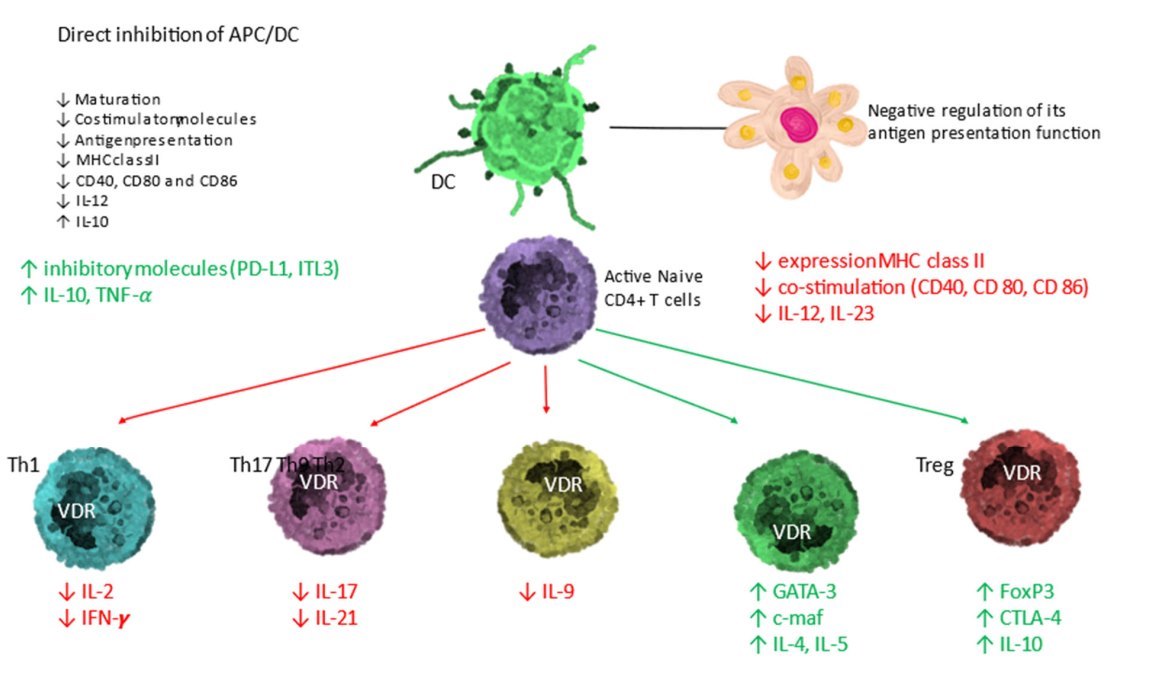
Response to Calcifediol
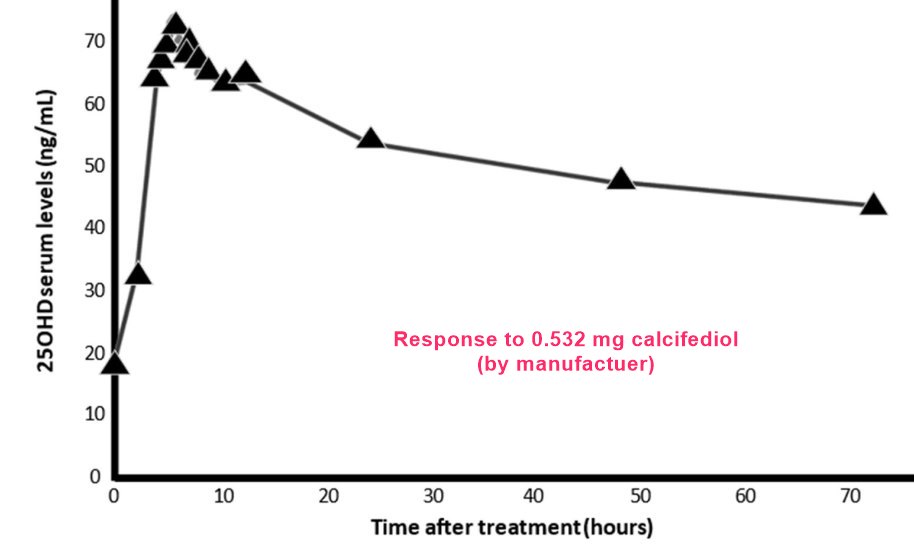
The COVID-19 pandemic is the greatest challenge facing modern medicine and public health systems. The viral evolution of SARS-CoV-2, with the emergence of new variants with in-creased infectious potential, is a cause for concern. In addition, vaccination coverage remains in-sufficient worldwide. Therefore, there is a need to develop new therapeutic options, and/or to optimize the repositioning of drugs approved for other indications for COVID-19. This may include the use of calcifediol, the prohormone of the vitamin D endocrine system (VDES) as it may have potential useful effects for the treatment of COVID-19. We review the aspects associating COVID-19 with VDES and the potential use of calcifediol in COVID-19. VDES/VDR stimulation may enhance innate antiviral effector mechanisms, facilitating the induction of antimicrobial peptides/autophagy, with a critical modulatory role in the subsequent host reactive hyperinflammatory phase during COVID-19: By decreasing the cytokine/chemokine storm, regulating the renin–angiotensin–bradykinin system (RAAS), modulating neutrophil activity and maintaining the integrity of the pulmonary epithelial barrier, stimulating epithelial repair, and directly and indirectly decreasing the increased coagulability and prothrombotic tendency associated with severe COVID-19 and its complications. Available evidence suggests that VDES/VDR stimulation, while maintaining optimal serum 25OHD status, in patients with SARS-CoV-2 infection may significantly reduce the risk of acute respiratory distress syndrome (ARDS) and severe COVID-19, with possible beneficial effects on the need for mechanical ventilation and/or intensive care unit (ICU) admission, as well as deaths in the course of the disease. The pharmacokinetic and functional characteristics of calcifediol give it superiority in rapidly optimizing 25OHD levels in COVID-19. A pilot study and several observational intervention studies using high doses of calcifediol (0.532 mg on day 1 and 0.266 mg on days 3, 7, 14, 21, and 28) dramatically decreased the need for ICU admission and the mortality rate.
We, therefore, propose to use calcifediol at the doses described for the rapid correction of 25OHD deficiency in all patients in the early stages of COVID-19, in association, if necessary, with the new oral antiviral agents.
📄 Download the PDF from VitaminDWiki
Calcifediol for Use in Treatment of Respiratory Disease - June 2022
Nutrients 2022, 14(12), 2447; https://doi.org/10.3390/nu14122447
by Marta Entrenas-Castillo 1,2,Lourdes Salinero-González 3,Luis M. Entrenas-Costa 1,2,4 andRubén Andújar-Espinosa 5,6,*
Calcifediol is the prohormone of the vitamin D endocrine system (VDES). It requires hydroxylation to move to 1,25(OH)2D3 or calcitriol, the active form that exerts its functions by activating the vitamin D receptor (VDR) that is expressed in many organs, including the lungs. Due to its rapid oral absorption and because it does not require first hepatic hydroxylation, it is a good option to replace the prevalent deficiency of vitamin D (25 hydroxyvitamin D; 25OHD), to which patients with respiratory pathologies are no strangers. Correcting 25OHD deficiency can decrease the risk of upper respiratory infections and thus improve asthma and COPD control. The same happens with other respiratory pathologies and, in particular, COVID-19. Calcifediol may be a good option for raising 25OHD serum levels quickly because the profile of inflammatory cytokines exhibited by patients with inflammatory respiratory diseases, such as asthma, COPD or COVID-19, can increase the degradation of the active metabolites of the VDES. The aim of this narrative revision is to report the current evidence on the role of calcifediol in main respiratory diseases. In conclusion, good 25OHD status may have beneficial effects on the clinical course of respiratory diseases, including COVID-19. This hypothesis should be confirmed in large, randomized trials. Otherwise, a rapid correction of 25(OH)D deficiency can be useful for patients with respiratory disease.
📄 Download the PDF from VitaminDWiki
Effect of Calcifediol on Physical Performance and Muscle Strength Parameters: A Systematic Review and Meta-Analysis - April 2022
Nutrients 2022, 14(9), 1860; https://doi.org/10.3390/nu14091860
by Mario Barbagallo 1ORCID,Nicola Veronese 1ORCID,Agnese Di Prazza 1ORCID,Francesco Pollicino 1,Luca Carruba 1,Anna La Carrubba 1 andLigia J. Dominguez 1,2,*
1 Geriatric Unit, Department of Internal Medicine and Geriatrics, University of Palermo, 90127 Palermo, Italy
2 Faculty of Medicine and Surgery, Kore University of Enna, 94100 Enna, Italy
There is general agreement that optimal vitamin D status is necessary for bones, muscles, and general health, particularly in older adults, who are at higher risk of negative consequences of vitamin D deficiency, including sarcopenia; vitamin D supplementation is proposed as a potential intervention to mitigate sarcopenia. Several RCTs have reported that calcifediol (25(OH)D) was more potent than cholecalciferol in increasing plasma 25(OH)D. The present systematic review and meta-analysis aimed to summarize the effects of calcifediol on physical performance and muscle strength. We searched databases from inception to 1 January 2022 for studies investigating calcifediol on physical performance or muscle strength parameters. We calculated the difference between the means of follow-up vs. baseline data using standardized mean differences (SMD) and their 95% confidence intervals (CIs); a random-effect model was considered for all of the analyses. Seven RCTs were included in the meta-analysis. Calcifediol significantly improved gait speed (SMD = 2.500; 95%CI = 1.768–3.223; p < 0.0001); handgrip strength (n = 5446 participants, SMD = 0.532; 95%CI: 0.305–0.758; p < 0.0001; I2 = 20.2%); and leg extension (n = 4318 participants, SMD = 0.641; 95%CI: 0.346 to 0.935; p < 0.0001; I2 = 18.8%;) vs. baseline values. In conclusion, in this systematic review and meta-analysis, we observed that calcifediol may have a positive effect on muscle strength parameters, with less evidence on physical performance. These data further indicate the importance of vitamin D and, in particular, of calcifediol, not only on bone metabolism but also on muscle parameters and sarcopenia.
📄 Download the PDF from VitaminDWiki
See in VitaminDWiki - Muscle strength improved with Calfidediol (a form of vitamin D) - meta-analysis May 2022
Treatment of Vitamin D Deficiency with Calcifediol: Efficacy and Safety Profile and Predictability of Efficacy - May 2022
Nutrients 2022, 14(9), 1943; https://doi.org/10.3390/nu14091943
by Jose-Luis Pérez-Castrillon 1,*,Ricardo Usategui-Martín 2,3 andPawel Pludowski 4ORCID
1 Servicio de Medicina Interna, Hospital Universitario Río Hortega, University of Valladolid, 47012 Valladolid, Spain
2 Department of Cell Biology, Histology and Pharmacology, Faculty of Medicine, University of Valladolid, 47003 Valladolid, Spain
3 IOBA, University of Valladolid, 47011 Valladolid, Spain
4 Department of Biochemistry, Radioimmunology and Experimental Medicine, The Children’s Memorial Health Institute, 04730 Warsaw, Poland

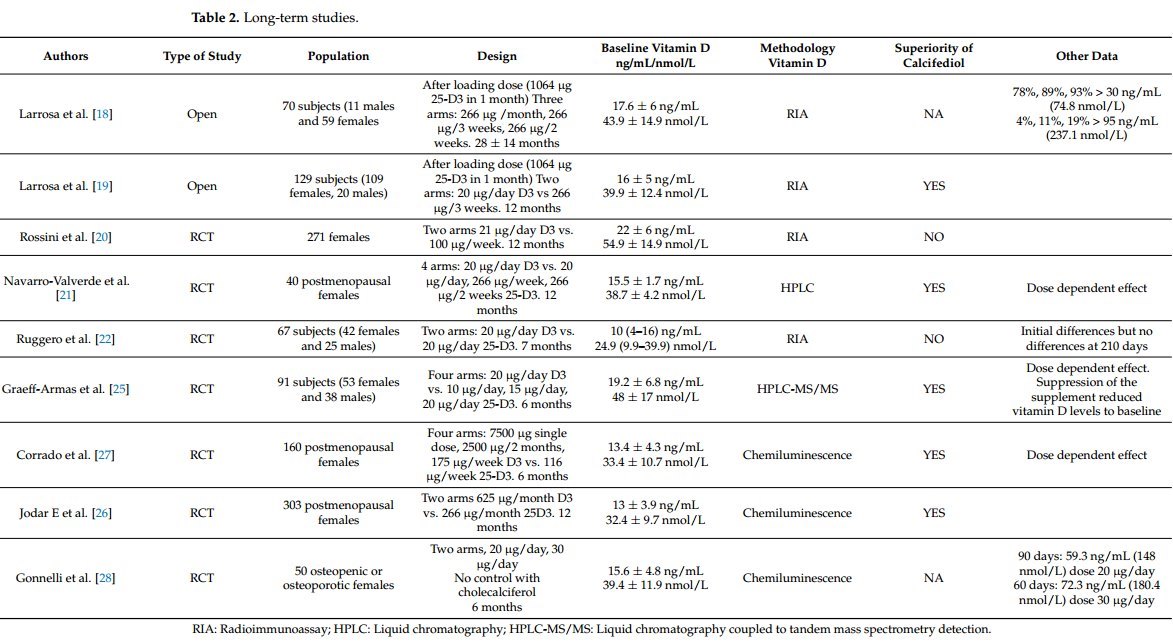
Calcifediol (25-OH-vitamin D3) is the prohormone of the vitamin D endocrine system. It is used to prevent and treat vitamin D deficiency. Calcifediol, as well as cholecalciferol (vitamin D3), is efficient and safe in the general population, although calcifediol has certain advantages over cholecalciferol, such as its rapid onset of action and greater potency. This review analyzed studies comparing the efficacy and safety of both calcifediol and cholecalciferol drugs in the short and long term (>6 months). Calcifediol was found to be more efficacious, with no increase in toxicity. We also assessed the predictability of both molecules. A 25OHD increase depends on the dose and frequency of calcifediol administration. In contrast, after cholecalciferol administration, 25OHD increase depends on more factors than dose and frequency of administration, also phenotypic aspects (such as obesity and malabsorption), and genotypic factors impacts in this increase.
📄 Download the PDF from VitaminDWiki
25(OH)Vitamin D Deficiency and Calcifediol Treatment in Pediatrics - April 2022
Nutrients 2022, 14(9), 1854; https://doi.org/10.3390/nu14091854
by Luis Castano *,Leire MadariagaORCID,Gema Grau andAlejandro García-Castaño
Cruces University Hospital, Biocruces Bizkaia Health Research Institute, UPV/EHU, CIBERER/CIBERDEM, Endo-ERN, 48903 Barakaldo, Spain
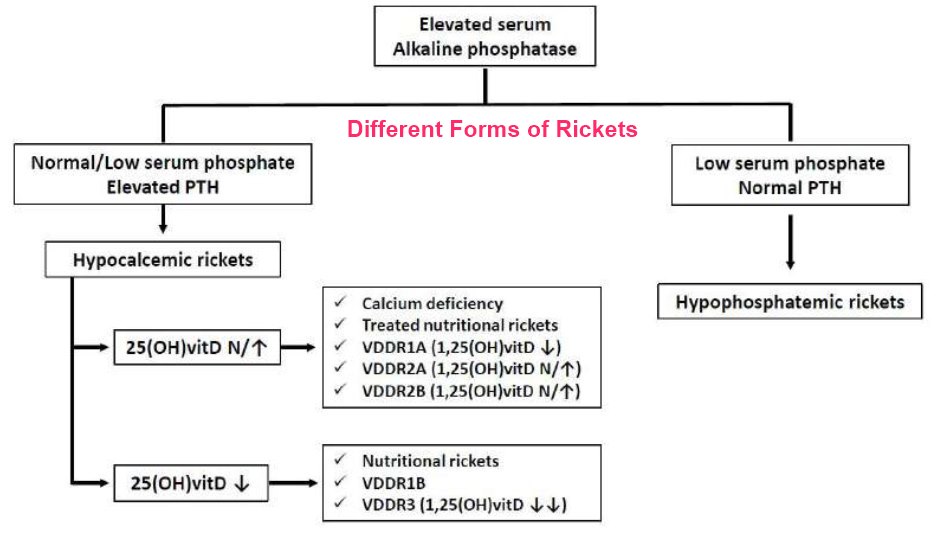
Vitamin D is essential for the normal mineralization of bones during childhood. Although diet and adequate sun exposure should provide enough of this nutrient, there is a high prevalence of vitamin D deficiency rickets worldwide. Children with certain conditions that lead to decreased vitamin D production and/or absorption are at the greatest risk of nutritional rickets. In addition, several rare genetic alterations are also associated with severe forms of vitamin-D-resistant or -dependent rickets. Although vitamin D3 is the threshold nutrient for the vitamin D endocrine system (VDES), direct measurement of circulating vitamin D3 itself is not a good marker of the nutritional status of the system. Calcifediol (or 25(OH)D) serum levels are used to assess VDES status. While there is no clear consensus among the different scientific associations on calcifediol status, many clinical trials have demonstrated the benefit of ensuring normal 25(OH)D serum levels and calcium intake for the prevention or treatment of nutritional rickets in childhood. Therefore, during the first year of life, infants should receive vitamin D treatment with at least 400 IU/day. In addition, a diet should ensure a normal calcium intake. Healthy lifestyle habits to prevent vitamin D deficiency should be encouraged during childhood. In children who develop clinical signs of rickets, adequate treatment with vitamin D and calcium should be guaranteed. Children with additional risk factors for 25(OH)D deficiency and nutritional rickets should be assessed periodically and treated promptly to prevent further bone damage.
📄 Download the PDF from VitaminDWiki
Calcifediol (25OHD) Deficiency and Its Treatment in Women’s Health and Fertility - April 2022
Nutrients 2022, 14(9), 1820; https://doi.org/10.3390/nu14091820
by Ana Arnanz 1,2,Juan A. Garcia-Velasco 1ORCID andJosé Luis Neyro 3,*ORCID
1 IVIRMA, 28023 Madrid, Spain
2 Departamento de Biomedicina y Biotecnología, Universidad de Alcalá de Henares, 28023 Madrid, Spain
3 Academia de Ciencias Médicas de Bilbao, Gynecology and Obstetrics Service, Hospital Universitario Cruces, 48009 Bilbao, Spain
Currently, there is abundant scientific evidence showing that the vitamin D endocrine system (VDES) is a highly complex endocrine system with multiple actions in different regions of the body. The unequivocal presence of vitamin D receptors in different tissues related to fertility, and to specific aspects of women’s health such as pregnancy, undoubtedly implies functions of this steroid hormone in both male and female fertility and establishes relationships with different outcomes of human gestation. In order to review the role of the VDES in human fertility, we evaluated the relationships established between 25-hydroxyvitamin D (calcifediol) deficiency and in vitro fertilization, as well as aspects related to ovarian reserve and fertility, and commonly diagnosed endocrinopathies such as polycystic ovary disease. Likewise, we briefly reviewed the relationships between calcifediol deficiency and uterine fibroids, as well as the role that treatment may have in improving human fertility. Finally, the best scientific evidence available on the consequences of calcifediol deficiency during pregnancy is reviewed in relation to those aspects that have accumulated the most scientific literature to date, such as the relationship with the weight of the newborn at the time of delivery, the appearance of preeclampsia, and the risk of developing gestational diabetes and its final consequences for the pregnancy. To date, there is no definitive consensus on the necessary dose for treatment of calcifediol deficiency in the therapeutic management of infertility or during pregnancy. Large prospective clinical intervention studies are needed to clarify the benefits associated with this supplementation and the optimal dose to use in each situation. Although most intervention studies to date have been conducted with cholecalciferol, due to its much longer history of use in daily care, the use of calcifediol to alleviate 25-hydroxyvitamin D deficiency seems safe, even during pregnancy. The unequivocal presence of vitamin D receptors in very different tissues related to human fertility, both male and female, as well as in structures typical of pregnancy, allows us to investigate the crucial role that this steroid hormone has in specific aspects of women’s health, such as pregnancy and the ability to conceive. Well-designed clinical studies are needed to elucidate the necessary dose and the best form of treatment to resolve the very common calcifediol deficiency in women of reproductive age
📄 Download the PDF from VitaminDWiki
Calcifediol (25OH Vitamin D3) Deficiency: A Risk Factor from Early to Old Age - March 2022
Nutrients 2022, 14(6), 1168; https://doi.org/10.3390/nu14061168
by Roger Bouillon 1,*,Leen Antonio 1,2ORCID andOscar Rosero Olarte 3ORCID
1 Clinical and Experimental Endocrinology, Department of Chronic Diseases and Metabolism, Catholic University of Leuven, 3000 Leuven, Belgium
2 Department of Endocrinology, University Hospitals Leuven, 3000 Leuven, Belgium
3 Clinical Endocrinology, Asociación Colombiana de Osteoporosis, Bogotá 500005, Colombia
Vitamin D deficiency is the main cause of nutritional rickets in children and osteomalacia in adults. There is consensus that nutritional access to vitamin D can be estimated by measuring serum concentrations of 25OHD and vitamin D deficiency can thus be considered as calcifediol deficiency. However, the threshold for vitamin D/calcifediol sufficiency remains a matter of debate. Vitamin D/calcifediol deficiency has been associated with musculoskeletal effects but also multiple adverse extra-skeletal consequences. If these consequences improve or if they can be treated with vitamin D supplementation is still unclear. Observational studies suggest a higher infection risk in people with low calcifediol levels. There is also a consistent association between serum calcifediol and cardiovascular events and deaths, but large-scale, long-term intervention studies did not show any benefit on cardiovascular outcomes from supplementation, at least not in subjects without clear vitamin D deficiency. Cancer risk also did not change with vitamin D treatment, although there are some data that higher serum calcifediol is associated with longer survival in cancer patients. In pregnant women, vitamin D supplementation decreases the risk of pre-eclampsia, gestational diabetes mellitus, and low birth weight. Although preclinical studies showed that the vitamin D endocrine system plays a role in certain neural cells as well as brain structure and function, there is no evidence to support a beneficial effect of vitamin D in neurodegenerative diseases. Vitamin D supplementation may marginally affect overall mortality risk especially in elderly subjects with low serum calcifediol concentrations.
📄 Download the PDF from VitaminDWiki
Rapid Nontranscriptional Effects of Calcifediol and Calcitriol - March 2022
Nutrients 2022, 14(6), 1291; https://doi.org/10.3390/nu14061291
by Simone Donati 1,Gaia Palmini 1ORCID,Cinzia Aurilia 1,Irene Falsetti 1,Francesca Miglietta 1,Teresa Iantomasi 1ORCID andMaria Luisa Brandi 2,*
1 Department of Experimental and Clinical Biomedical Sciences, University of Florence, 50139 Florence, Italy
2 Fondazione Italiana Ricerca sulle Malattie dell’Osso (F.I.R.M.O. Onlus) Italian Foundation for the Research on Bone Diseases, 50141 Florence, Italy
Classically, a secosteroid hormone, vitamin D, has been implicated in calcium and phosphate homeostasis and has been associated with the pathogenesis of rickets and osteomalacia in patients with severe nutritional vitamin D deficiency. The spectrum of known vitamin D-mediated effects has been expanded in recent years. However, the mechanisms of how exactly this hormone elicits its biological function are still not fully understood. The interaction of this metabolite with the vitamin D receptor (VDR) and, subsequently, with the vitamin D-responsive element in the region of specific target genes leading to the transcription of genes whose protein products are involved in the traditional function of calcitriol (known as genomic actions). Moreover, in addition to these transcription-dependent mechanisms, it has been recognized that the biologically active form of vitamin D3, as well as its immediate precursor metabolite, calcifediol, initiate rapid, non-genomic actions through the membrane receptors that are bound as described for other steroid hormones. So far, among the best candidates responsible for mediating rapid membrane response to vitamin D metabolites are membrane-associated VDR (VDRm) and protein disulfide isomerase family A member 3 (Pdia3). The purpose of this paper is to provide an overview of the rapid, non-genomic effects of calcifediol and calcitriol, whose elucidation could improve the understanding of the vitamin D3 endocrine system. This will contribute to a better recognition of the physiological acute functions of vitamin D3, and it could lead to the identification of novel therapeutic targets able to modulate these actions.
📄 Download the PDF from VitaminDWiki
Vitamin D supplementation: cholecalciferol, calcifediol, and calcitriol - Vieth 2020
Eur J Clin Nutr. 2020 Nov;74(11):1493-1497. doi: 10.1038/s41430-020-0697-1 PDF is behind a paywall
Reinhold Vieth 1

The specific compound that is meant for use in the context of vitamin D supplementation is often ambiguous. The term "supplementation" has been used in the context of cholecalciferol, ergocalciferol, calcidiol, and calcitriol. In nature, by far the major form of vitamin D that nurtures the body is cholecalciferol. In contrast, ergocalciferol is primarily a synthetic and less stable product which is less potent per microgram dose than is cholecalciferol. Calcidol is the major circulating metabolite of cholecalciferol, while calcitriol is the hormone that upregulates the active transport of calcium from the gut, and which suppresses parathyroid hormone secretion. Nutrition policy papers and guidelines leave unstated the obvious fact that calcidiol and calcitriol are not nutrients, and that those metabolites are not pertinent to food fortification or dietary supplementation. Recent evidence shows that ergocalciferol is not stable with storage, and it is far more susceptible to breakdown with cooking and baking than is cholecalciferol. Therefore, it must be concluded that cholecalciferol is the only form of vitamin D that should be considered in the context of the nutritional functions of fortification and supplementation.
VitaminDWiki - studies in both categories Virus and Calcidiol
This list is automatically updated
{category}
45+ VitaminDWiki pages have CALCIFEDIOL etc. in the title
The list is automatically updated
{LIST()}
See also web
Cholecalciferol or Calcifediol in the Management of Vitamin D Deficiency May 2020 FREE PDF
Hypovitaminosis D: Is It Time to Consider the Use of Calcifediol? May 2019 FREE PDF
Effects of Weekly Supplementation of Cholecalciferol and Calcifediol Among the Oldest-Old People: Findings From a Randomized Pragmatic Clinical Trial Nov 2019 FREE PDF
VitaminDWiki - Nanoemulsion Vitamin D is faster and better - many studies
Personal observations found sublingual Nano to be much faster than oral Calcifediol
No data as of Jan 2024
Wonder if Calcifediol is stored in muscle/fat, and is available for breastfeeding
Getting Vitamin D into your blood and cells has the following chart
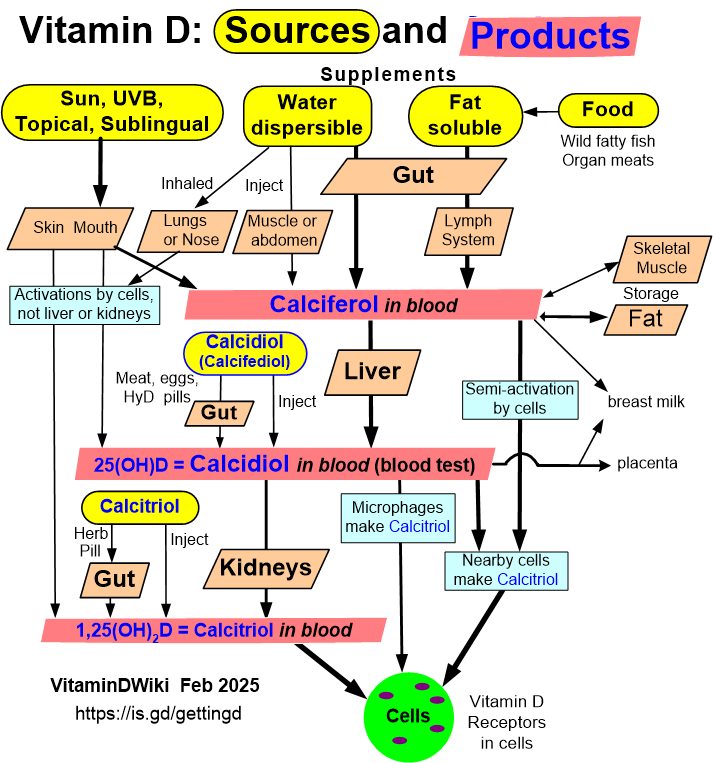
Short url = is.gd/calcifediol
